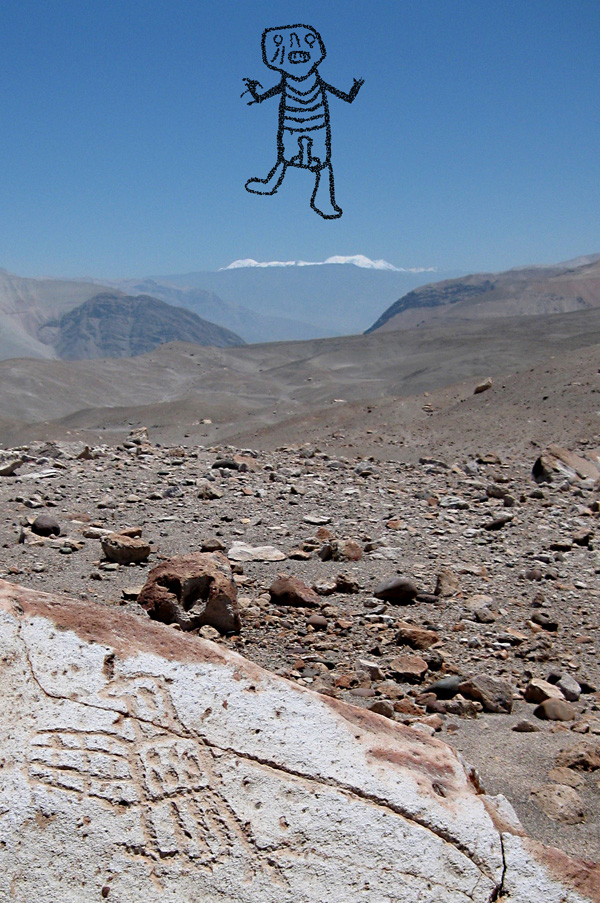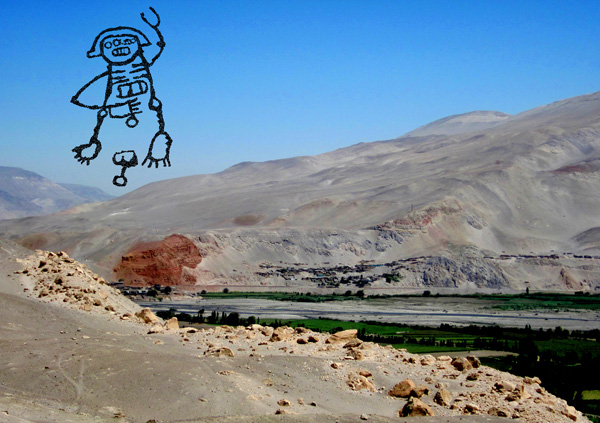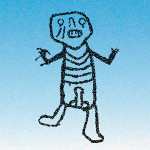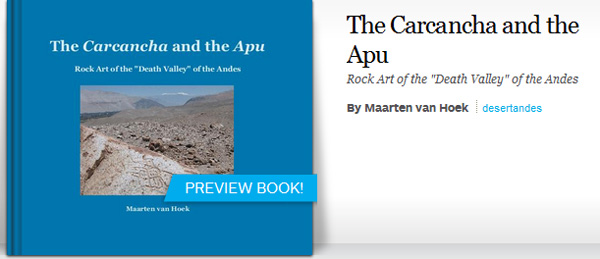This book is the first to explain the exceptional relationship between unique images of skeleton-anthropomorphic petroglyphs and one of the most important Sacred Mountains of the Andes.
El sitio de arte rupestre de Alto de Pitis es el más importante en el Valle de Majes por su unión única con una Montaña Sagrada.
by Maarten van Hoek
The Carcancha and the Apu – Rock Art in the Death Valley of the Andes
The Andes of South America boasts an enormous amount of prehistoric rock art. Many publications describe those rock art sites, but few explain the rock art in relation with specific landmarks. The recently published book “The Carcancha and the Apu – Rock Art in the Death Valley of the Andes” by Maarten van Hoek is the first publication that meticulously describes and explains the exceptional relationship between unique images of skeleton-anthropomorphic petroglyphs (Carcanchas) found at Alto de Pitis, a rock art site in the Majes Valley (The Death Valley of the Andes) and one of the most important Sacred Mountains (Apu) of the Andes, the volcano Nevado Coropuna, or Apu Qorpuna; both located in southern Peru, 80 km apart.

Figure 1: Petroglyph boulder at Alto de Pitis, southern Peru, looking north towards the 6425 meter high volcano of Apu Qorpuna. Inset: one of the many skeleton-anthropomorphs at Alto de Pitis. Photograph and drawing by Maarten van Hoek
The connection between the Carcancha and the Apu is a spiritual one, made visible through the many petroglyphs manufactured especially at Alto de Pitis, because in the Majes Valley Apu Qorpuna is only visible from Alto de Pitis. Importantly, the images of those Carcanchas depict the “Living Dead” as the important Andean duality of live and death is combined in images of skeleton-anthropomorphs that are clearly alive (they are often found in a saluting position and many have sexual organs), while at the same time they symbolise death, as they show an open rib cage, exposed teeth and bone-joints.
The book also comprehensively describes the discovery of Alto de Pitis that has long been credited to the late Dr. Eloy Linares Málaga, the investigator who reported the immense rock art site of Toro Muerto to the scientific world in 1951. However, the first person to ever record, photograph and publish rock art from Alto de Pitis and in fact in the Majes Valley was the well known explorer Hiram Bingham (the discoverer of the Inca citadel Machu Picchu) on the 7th of October 1911. The “Carcancha and the Apu” is dedicated to both these prominent explorers.
The book (10 x 8 inches / 25 x 20 cm) has been written in the English language and has 180 pages. The text has been printed in Georgia – mainly 9 points. The text has more than 75.000 words (including a List of Figures and a Bibliography). The book has been lavishly decorated with more than 170 illustrations (many colour photos and numerous drawings and maps). Full details about the book, the price and how-to-purchase a copy may be obtained at the following web page where also a selection of pages may be viewed:
http://www.blurb.com/user/store/desertandes
and
http://www.blurb.com/b/4161795-the-carcancha-and-the-apu
Estimado colega,
Tengo el placer de informarle que mi último trabajo sobre el Arte Rupestre Andino está disponible ahora. El título del libro es: ‘The Carcancha and the Apu, y el subtítulo del libro es ‘Rock Art in the Death Valley of the Desert Andes’. El libro trata el arte rupestre de un pequeña área en el sur del Perú, especialmente el Valle de Majes en el Departamento de Arequipa, pero sobre todo el sitio rupestre de Alto de Pitis. El sitio de Alto de Pitis es el sitio más importante en el Valle de Majes por su unión única con un Apu Coropuna (una Montaña Sagrada) en este área.
El libro (10 x 8 inches / 25 x 20 cm) ha sido escrito en la lengua inglesa. El libro tiene 180 páginas. El texto ha sido imprimido en Georgia – 8 y 9 puntos. El texto tiene aproximadamente más que 75.000 palabras. El libro ha sido espléndidamente decorado con más que 170 ilustraciones (muchas fotos en color y numerosos dibujos).
Todos los detalles sobre el libro, el precio y la manera de adquirir una copia puede obtenerse en la siguiente página web donde también pueden mirar una selección de páginas:
http://www.blurb.com/b/4161795-the-carcancha-and-the-apu
Maarten van Hoek
HOLLAND

Figure 2: Petroglyph boulder field at Alto de Pitis, southern Peru, looking south towards the Red Spot at Punta Colorada and the Majes Valley. Inset: one of the many skeleton-anthropomorphs at Alto de Pitis. Photograph and drawing by Maarten van Hoek
















Leave a Reply